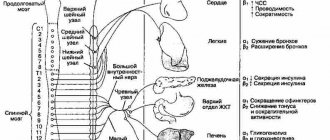Adrenergic stimulants (adrenergic agonists) are medications that stimulate different types of adrenergic receptors in organs and tissues, thereby imitating the effects of natural biologically active substances - the mediator norepinephrine and the adrenal hormone adrenaline.
Norepinephrine is a transmitter of impulses in the peripheral nervous system, regulating the functioning of many internal organs and systems (in particular, the heart, blood vessels, bronchi, uterus, pancreas, urinary system, etc.). Adrenaline is similar in structure and function to norepinephrine and is a hormone of the inner (brain) layer of the adrenal cortex.
Norepinephrine and adrenaline realize their effects through interaction with special structural components of cells - receptors, namely adrenergic receptors. Depending on their location and functions, adrenergic receptors are classified into alpha (α)- and beta (β)-adrenergic receptors.
α-Adrenergic receptors are located mainly in blood vessels, the iris of the eye, and the urinary tract. The effects of α-adrenergic receptor stimulation include constriction of blood vessels (and consequently increased blood pressure), pupil dilation, and urinary retention.
β-Adrenergic receptors are localized primarily in the heart (β1-adrenergic receptors), as well as in the bronchi and uterus (β2-adrenergic receptors). When they are stimulated, an increase in the strength and frequency of heart contractions, dilation of the bronchi and relaxation of the uterus are observed.
There is a separate class of drugs that can stimulate adrenergic receptors (adrenergic agonists, adrenergic stimulants), and a group of drugs that can block adrenergic receptors (adrenergic blockers, adrenergic steroids).
Depending on the degree of selectivity, adrenergic stimulants are divided into α-adrenergic agonists, β-adrenergic agonists, as well as α- and β-adrenergic agonists. Let us consider in detail drugs that stimulate β-adrenergic receptors.
Indications for use
β1-adrenergic agonists are used for acute heart failure associated with low cardiac output - against the background of myocardial infarction, cardiomyopathies, cardiogenic shock, and during heart surgery.
β2-adrenergic agonists are used for diseases associated with bronchospasm - bronchial asthma, chronic obstructive pulmonary disease.
Also, β2-adrenergic agonists are prescribed when there is a threat of premature birth.
β3-adrenergic agonists are used for diseases associated with increased bladder tone - overactive bladder syndrome: urinary incontinence, frequent urination.
pharmachologic effect
β1-Adrenergic agonists stimulate β1-adrenergic receptors in the myocardium, which leads to an increase in the strength and frequency of heart contractions (and, as a consequence, cardiac output and blood pressure).
β2-Adrenergic agonists stimulate β2-adrenergic receptors in the bronchi, providing a bronchodilator (bronchodilator) effect, and also, due to stimulation of β2-adrenergic receptors of the uterus, have a tocolytic effect (relax the muscles of the uterus).
β3-Adrenergic agonists stimulate β3-adrenergic receptors in the bladder, relaxing its muscles and preventing urinary incontinence.
Alpha adrenergic agonists
Alpha adrenergic agonists are represented by drugs that act mainly on alpha adrenergic receptors, and they can be selective (only on one type) and non-selective (acting on both α1 and α2 molecules). Norepinephrine, which also stimulates beta receptors, is considered a non-selective drug.
Selective alpha1-adrenergic agonists include mezatone, etilephrine, and midodrine.
Drugs in this group have a good anti-shock effect by increasing vascular tone and spasm of small arteries, therefore they are prescribed for severe hypotension and shock. Their local use is accompanied by vasoconstriction; they can be effective in the treatment of allergic rhinitis and glaucoma.
Drugs that excite alpha2 receptors are more common
due to the possibility of predominantly local use. The most famous representatives of this class of adrenergic agonists are naphthyzine, galazolin, xylometazoline, and visine. These drugs are widely used to treat acute inflammatory processes of the nose and eyes. Indications for their use include allergic and infectious rhinitis, sinusitis, and conjunctivitis.
Due to the rapid onset of the effect and the availability of these drugs, they are very popular as medicines that can quickly relieve such an unpleasant symptom as nasal congestion. However, you should be careful when using them, because with excessive and prolonged use of such drops, not only drug resistance develops, but also atrophic changes in the mucosa, which can be irreversible.
The possibility of local reactions in the form of irritation and atrophy of the mucous membrane, as well as systemic effects (increased pressure, changes in heart rhythm) does not allow their long-term use, and they are also contraindicated for infants, people with hypertension, glaucoma, and diabetes. It is clear that both hypertensive and diabetic patients still use the same nasal drops as everyone else, but they should be very careful. Special products are produced for children that contain a safe dose of adrenergic agonists, and mothers must ensure that the child does not get an excess amount of them.
Selective centrally acting alpha2-adrenergic agonists
not only have a systemic effect on the body, they can pass through the blood-brain barrier and activate adrenergic receptors directly in the brain. Their main effects are:
- Reduce blood pressure and heart rate;
- Normalizes heart rate;
- They have a sedative and pronounced analgesic effect;
- Reduce the secretion of saliva and tear fluid;
- Reduce the secretion of water in the small intestine.
Methyldopa, clonidine, guanfacine, catapresan, dopegit are widely used
, which are used in the treatment of arterial hypertension. Their ability to reduce salivary secretion, provide an anesthetic effect and soothe allows them to be used as additional drugs during anesthesia and as anesthetics during spinal anesthesia.
Basics of treatment with β-adrenergic agonists
β-Adrenergic stimulants are classified as prescription drugs - drugs are dispensed from pharmacies only with a doctor's prescription.
The β1-adrenergic agonist dobutamine is administered intravenously in a hospital setting under the constant supervision of a physician. The effect of the drug develops after 1-2 minutes, the maximum effect is observed after 10 minutes.
For the treatment of bronchial asthma and chronic obstructive pulmonary disease, β2-adrenergic agonists are used by inhalation.
To prevent premature birth, β2-agonists are used as intravenous injections, infusions, or taken orally (orally) as tablets.
Mirabegron is used orally in tablet form once a day.
Features of treatment with β-adrenergic agonists
Salbutamol and fenoterol have a rapid (the effect develops within 1-3 minutes) but short-lived (3-6 hours) effect, so they are used to relieve (eliminate) attacks of bronchial asthma.
Salmeterol and formoterol have a long-lasting effect - more than 12 hours; in addition, the effect of these drugs does not develop immediately, but only 30 minutes after use. That is why salmeterol and formoterol are used to prevent the development of bronchospasms.
In the long-term treatment of bronchial asthma and chronic obstructive pulmonary disease, combination drugs are used, which include both β2-adrenergic agonists and M-cholinergic blockers (ipratropium bromide, tiotropium bromide, umeclidinium bromide, aclidinium bromide, glycopyrronium bromide), as well as hormonal drugs of the class glucocorticosteroids (fluticasone, budesonide).
PsyAndNeuro.ru
The material was prepared jointly by the educational project “Psychiatry & Neuroscience” and the Clinic of Psychiatry and Narcology Doctor SAN.
We present to your attention comprehensive practical recommendations for psychopharmacotherapy for diseases of the respiratory system. The recommendations describe psychiatric symptoms often encountered in diseases of the respiratory system, their differential diagnosis, neuropsychiatric side effects of drugs for the treatment of diseases of the respiratory system, drug interactions, as well as the effectiveness and safety of psychotropic drugs in diseases of the respiratory system.
Asthma, chronic obstructive pulmonary disease (COPD), cystic fibrosis, tuberculosis, obstructive sleep apnea, vocal cord dysfunction, pulmonary embolism - all of these diseases may have symptoms that require psychopharmacological treatment. Most of these diseases (except for cystic fibrosis, or if the patient smokes) do not affect the metabolism of pulmonary or other drugs. The main thing is to avoid taking medications that suppress the activity of the respiratory center or otherwise negatively affect ventilation of the lungs.
Asthma:
Anxiety, depression, substance abuse (marijuana, crack cocaine), sleep disorders
COPD:
Anxiety, depression, nicotine addiction, cognitive decline, sleep disorders, sexual dysfunction, fatigue
Cystic fibrosis:
Depression, anxiety, eating disorders
Vocal cord dysfunction:
Anxiety, depression, conversion disorder
Hyperventilation syndrome:
Anxiety, depression, pseudoconvulsions
Sleep apnea:
Drowsiness, sleep disturbances, irritability, depression, cognitive decline
Tuberculosis:
Psychosis, sleep disturbances, substance abuse, cognitive impairment, fatigue, lethargy, mania, delirium
In all of these diseases, psychiatric symptoms often occur, requiring the prescription of psychotropic drugs. Diagnosis can be difficult because symptoms of respiratory diseases overlap with symptoms of mental disorders. In addition, a cyclical sequence of psychiatric and respiratory symptoms is common, making it difficult to determine the underlying cause of the condition in the presence of associated factors.
Anxiety
Shortness of breath, chest tightness and a feeling of suffocation are common in anxiety disorders and respiratory diseases. Somatic manifestations of anxiety may be caused by a comorbid anxiety disorder, anxiety in response to a respiratory disorder, or the respiratory disorder itself.
It is important, if possible, to carry out differentiated diagnostics; if the symptoms have a physiological basis (for example, hypoxia), then they need to be addressed regardless of the treatment of anxiety or in conjunction with this treatment. For example, with pulmonary embolism, shortness of breath and hyperventilation may occur in the absence of chest pain, which may be mistaken for a panic attack.
Anxiety disorders, especially panic disorder, must be considered in the differential diagnosis of vocal cord dysfunction. Anxiety disorders occur in nearly one in three patients with asthma presenting to primary care; Anxiety can trigger asthma attacks. Theophylline and many beta-agonists may cause or worsen anxiety. Anxiety often accompanies vocal cord dysfunction and pulmonary embolism. Anxiety disorders, especially panic disorder with agoraphobia, occur with increased frequency in patients with COPD.
Depression
Patients with asthma, COPD and cystic fibrosis are more likely to experience depressive symptoms than the general population. Diagnosing depression can be difficult in patients with chronic respiratory diseases because many symptoms overlap, such as fatigue, poor sleep, decreased ability to perform activities, weight loss, and anorexia. Tuberculosis may cause diagnostically confusing signs of depression, such as weight loss, lethargy, sleep disturbances, loss of interest in daily activities, and confusion.
Sleep disorders
Sleep disturbances can be caused by apnea, nocturnal cough, nocturnal asthma attacks, medication side effects, and comorbid anxiety or depression. More than 50% of COPD patients complain of sleep disturbances. Many patients with COPD have obstructive sleep apnea, leading to daytime sleepiness, insomnia, and very often irritability and depressive symptoms. These patients may experience significant difficulties with concentration, attention, and memory.
Cognitive deficit
Cognitive dysfunction is common in patients with COPD, even in those who do not have chronic hypoxia or hypercapnia. Patients with severe COPD may develop irreversible cognitive deficits and subclinical encephalopathy due to repeated episodes of hypoxia or chronic hypoxia. Oxygen therapy helps minimize cognitive deficits in patients with mild hypoxia. Cognitive deficits may have potentially reversible causes, such as hypercapnia or exacerbation of underlying cardiac disease.
Drugs used in the treatment of diseases of the respiratory system often cause neuropsychiatric side effects.
Anticholinergics
Atropine: Paranoia; tactile, visual and auditory hallucinations; memory loss; delirium; agitation
Beta-agonists
Salbutamol, levosalbutamol: Anxiety, insomnia, paranoia, hallucinations, tremors, rapid heartbeat
Formoterol, arformoterol: Insomnia, anxiety, tremor, rapid heartbeat
Isoproterenol: Anxiety, insomnia, tremor
Metaproterenol: Anxiety, insomnia
Pirbuterol: Anxiety, tremors
Salmeterol: Anxiety, tremors, rapid heartbeat
Bronchodilators
Aminophylline, theophylline: Anxiety, insomnia, tremor, restlessness, withdrawal syndrome, hyperactivity, psychosis, delirium, mutism
Oral corticosteroids
Prednisone, prednisolone, dexamethasone: Depression, mania, emotional instability, anxiety, insomnia, psychosis, hallucinations, paranoia, personality changes
Leukotriene inhibitors
Montelukast: Fatigue, asthenia, suicidal ideation
Adrenergic agonists of mixed action
Adrenaline: Anxiety, tremors, psychosis
Phenylephrine: Depression, hallucinations, paranoia
Phenylpropanolamine: Restlessness, anxiety, insomnia, psychosis, hallucinations, aggressiveness
Other drugs
Acetazolamide: confusion, feeling unwell
Modafinil: Nervousness, depression, anxiety
Corticosteroids
Inhaled corticosteroids rarely produce side effects, but oral corticosteroids (eg, prednisone, prednisolone, dexamethasone) may cause depression, mania, emotional lability, anxiety, insomnia, psychosis, hallucinations, paranoia, and personality changes.
Bronchodilators
The most common side effects of beta-adrenergic bronchodilators include nervousness and tremor. Albuterol may cause insomnia. Over-the-counter inhalers containing epinephrine or ephedrine can cause anxiety and, if taken in large doses, psychosis.
Adrenergic agonists of mixed action
Mixed-action adrenergic agonists are often used for asthma. Epinephrine, ephedrine, phenylephrine and phenylpropanolamine can cause anxiety, insomnia, tremor and psychosis.
Theophylline
Theophylline can cause increased neuro-reflex excitability, insomnia, anxiety, restlessness and irritability, which can be mistaken for a primary anxiety disorder or akathisia. Symptoms caused by theophylline are usually dose dependent and develop soon after taking the drug. Treatment involves reducing the dose to the lowest effective dose, changing the timing of administration, and/or switching to other asthma medications. A patient with anxiety may be able to avoid oral theophylline by using inhaled cromoglycic acid, ipratropium bromide, or steroids.
The toxic effects of theophylline include severe anxiety, severe nausea, headache, insomnia, and can cause delirium with severe agitation and psychosis. Theophylline should be discontinued until symptoms subside and blood test values return to the therapeutic range. Theophylline can cause and worsen tremors. If theophylline cannot be stopped, beta blockers or benzodiazepines can be used against tremor. Although beta blockers have relative contraindications in COPD and asthma due to their bronchoconstrictor effect, beta blockers with high cardioselectivity such as acebutolol, atenolol, celiprolol, metoprolol and practolol can be prescribed to patients with mild to moderate reactive airway disease, and also for patients with COPD.
Antibiotics and anti-tuberculosis drugs
Antibiotics used to treat infections associated with asthma or COPD usually produce minimal side effects. At the same time, taking anti-TB drugs is associated with more frequent and severe side effects, including depression, anorexia, anxiety, insomnia, delusions, hallucinations and toxic psychosis.
Anticholinergic drugs
Atropine, an anticholinergic drug that is rarely used to treat asthma, can cause paranoia, tactile, visual and auditory hallucinations, memory loss, delirium and agitation. Inhaled ipratropium bromide and tiotropium bromide are anticholinergic drugs that do not cause significant psychiatric side effects.
Leukotriene inhibitors
Montelukast may cause dizziness, fatigue, asthenia, and suicidal ideation, although it is not associated with an increase in suicide attempts. Another leukotriene inhibitor, zafirlukast, does not appear to cause significant psychiatric side effects.
Drugs for the treatment of obstructive sleep apnea
Taking acetazolamide may cause confusion and feelings of illness. Modafinil, approved in the US as a treatment for daytime sleepiness, can cause nervousness, depression and anxiety.
For the most part, respiratory diseases do not affect pharmacokinetics, but there are two important exceptions: cystic fibrosis and smoking. Cystic fibrosis may alter pharmacokinetics due to impaired transport function of the cell membrane. The rate of absorption of the drug slows down, but the degree of absorption usually does not change, and the bioavailability remains the same. This does not affect the volume of distribution in any way. Cystic fibrosis increases oxidative hepatic metabolism, but only for the drug substrates cytochrome P450 (CYP) 1A2 and 2C8; metabolism by other cytochromes remains unchanged. There are few scientific studies on the use of lithium in patients with cystic fibrosis and the available data are contradictory. There are reports that renal clearance is reduced, resulting in higher lithium levels. At the same time, a clinical case was described in which the lithium level did not change. It is prudent to begin treatment with lithium in patients with cystic fibrosis at low doses and monitor their condition closely.
Smoking, in addition to causing diseases of the respiratory system, affects the pharmacodynamics and pharmacokinetics of many drugs. Smoking causes bronchoconstriction, which interferes with treatment and weakens the effect of taking bronchodilators. Smoking induces CYP1A2, which increases the metabolism of substrates of this hepatic enzyme, including clozapine, olanzapine, duloxetine and theophylline.
Psychotropic drugs for diseases of the respiratory system
Antidepressants
Antidepressants are often used to treat anxiety and depression in patients with chronic respiratory diseases. Most published studies have focused on the use of these drugs in patients with asthma and COPD; There is virtually no information on the use of antidepressants in patients with cystic fibrosis or tuberculosis, and little data has been collected on the use of antidepressants in patients with obstructive sleep apnea.
When treating patients with severe forms of COPD or obstructive sleep apnea, special care must be taken when combining sedating antidepressants with other sedatives, such as anxiolytics and hypnotics; sedative effects can lead to a weakening of the activity of the respiratory center. Very few studies have been conducted to evaluate the safety and effectiveness of antidepressants in patients with pulmonary disease, and therefore their safety can only be inferred from the lack of published reports of dangerous reactions.
It was previously thought that anticholinergic drugs were contraindicated in bronchospastic conditions, but tiotropium bromide is now often used? inhaled anticholinergic agent. Thus, although data are still limited, it can be assumed that the anticholinergic effect of a tricyclic antidepressant may reduce bronchoconstriction. It can also be expected that the drying effect of anticholinergic TCAs will be beneficial for asthma patients with heavy fluid secretions, but will worsen the condition in patients whose airways are clogged with thickened mucus. TCAs should not be prescribed to patients with cystic fibrosis because the anticholinergic drying effect will increase difficulty clearing mucus.
Apart from drug interaction issues, the use of antidepressants in patients with tuberculosis is safe. There are no studies examining the use of monoamine oxidase inhibitors in the setting of respiratory disease, but these drugs are known to be associated with serious drug interaction problems.
Benzodiazepines
The inhibitory effect of benzodiazepines on respiratory activity can significantly impair the response of pulmonary ventilation. This may lead to the development of respiratory failure in patients with limited respiratory reserve, so benzodiazepines are contraindicated in hypercapnia. Patients with severe bronchitis, severe restrictive pulmonary disease, or sleep apnea are most susceptible to the adverse effects of benzodiazepines.
At the same time, benzodiazepines are not contraindicated in COPD and asthma. Worsening anxiety often has a negative impact on the respiratory system, and in such cases, benzodiazepines improve the condition of patients with asthma or emphysema. In contrast, in patients with obstructive sleep apnea, benzodiazepines suppress respiratory activity, which can increase the duration of apnea episodes and lead to dangerous consequences.
Benzodiazepines help with severe episodes of vocal cord dysfunction. When prescribing benzodiazepines, it is best to use reduced doses of shorter-acting drugs (for example, lorazepam) so that side effects are mild and disappear quickly after stopping use.
Other anxiolytics and hypnotics
Some nonbenzodiazepine drugs are useful for improving sleep in patients with respiratory diseases. Zolpidem helps patients with severe obstructive sleep apnea fall asleep without compromising the effectiveness of CPAP therapy. In addition, it does not worsen respiratory performance and pulmonary function tests in patients with COPD. In patients with mild to moderate sleep apnea, zopiclone improves sleep without impairing breathing. The effectiveness of trazodone in this group of patients has not been studied.
The drug of choice in patients with respiratory diseases suffering from chronic anxiety should be buspirone due to the fact that it does not have a depressant effect on breathing. Buspirone may improve respiratory status in patients with sleep apnea, exercise capacity, and shortness of breath in patients with chronic lung disease. There is evidence that buspirone is effective and well tolerated in combination with bronchodilators.
The use of barbiturates should be avoided in patients with respiratory impairment, severe COPD, or obstructive sleep apnea who are experiencing alcohol withdrawal. An exception may be long-term treatment of epilepsy with phenobarbital.
Antipsychotics
Although studies are small, clinical experience suggests that atypical and typical antipsychotics can be used in patients with respiratory disorders, with certain precautions regarding how extrapyramidal symptoms, weight gain, and tardive dyskinesia affect respiratory function and risk of aspiration pneumonia in elderly patients with dementia.
Laryngeal dystonia, manifested as acute shortness of breath, is an extremely rare form of acute dystonic reaction. It is usually associated with high-potency typical antipsychotics, but there are case reports with ziprasidone. Typically, this, like other dystonic reactions, occurs within 24-48 hours of starting antipsychotic therapy or, in rare cases, after increasing the dose. Laryngeal dystonia can be life-threatening, but usually resolves completely with intramuscular injection of anticholinergic drugs. Tardive dyskinesia affecting the respiratory muscles is a rare phenomenon that usually occurs with long-term use of typical antipsychotics and can lead to significant deterioration in breathing in patients with reduced tidal volume.
Weight gain while taking olanzapine, quetiapine, and other atypical antipsychotics is particularly problematic in patients with obstructive sleep apnea; additional weight worsens apnea. In addition, increased body weight may lead to decreased tidal volume in patients with impaired respiratory function, especially those with restrictive pulmonary disease. There is evidence that olanzapine and possibly risperidone may be associated with an increased risk of pulmonary embolism.
Patients taking atypical antipsychotics have a significantly increased risk of death from asthma. The risk is especially high in patients who have recently stopped taking antipsychotic medications. Patients with asthma and COPD are at increased risk of arrhythmia. If an antipsychotic must be prescribed, it is best to avoid the use of those drugs most likely to cause QT prolongation (ziprasidone, thioridazine), or, otherwise, carefully monitor the patient's condition. Abruptly stopping antipsychotics with significant anticholinergic effects, such as clozapine, may cause cholinergic rebound syndrome, which reduces the effectiveness of anticholinergic drugs for treating asthma. These medications should be discontinued slowly to prevent cholinergic rebound syndrome.
The use of antipsychotics in the treatment of older patients with dementia is associated with an increased risk of death from cardiovascular complications and infection, particularly pneumonia. Pneumonia in such cases may be associated with aspiration of secretions resulting from sedation and dysphagia.
Mood stabilizers
Several case reports suggest that carbamazepine is associated with pulmonary eosinophilia, diffuse parenchymal lung disease, and respiratory failure. Carbamazepine has also been found to be an effective treatment for asthma.
Psychostimulants
Chronic diseases of the respiratory system often lead to insomnia and daytime sleepiness. There is little research on the use of stimulants in patients with sleep apnea. Modafinil (and also armodafinil, the R-enantiomer of modafinil) increases daytime wakefulness when used as an adjunctive treatment in patients with obstructive sleep apnea who improve with CPAP therapy but still experience daytime sleepiness. Concentration and functioning are improved while sleep architecture remains unaffected. Atomoxetine improves the quality of wakefulness in patients with mild to moderate obstructive sleep apnea without worsening the index of respiratory events. However, since this topic remains poorly researched, and also because of the increased risk of arrhythmia in chronic diseases of the respiratory system, the use of psychostimulants should be treated with caution.
Antidementia drugs
The use of cognitive enhancers in patients with respiratory diseases has been poorly studied. Cholinesterase inhibitors increase acetylcholine levels and may cause bronchoconstriction. In addition, they are likely to block the therapeutic effect of bronchodilators, especially anticholinergic agents such as ipratropium bromide and tiotropium bromide. The most common pulmonary side effects of these drugs are shortness of breath and bronchitis, while uncommon side effects include pneumonia, hyperventilation, pulmonary edema, wheezing, hypoxia, pleurisy, pulmonary collapse, sleep apnea, and snoring.
Thus, cholinesterase inhibitors should be prescribed with caution, or better not at all, in patients with asthma and COPD. An alternative is memantine, which does not produce respiratory side effects.
Opioids
When dyspnea in patients with advanced pulmonary disease cannot be controlled, a variety of pharmacological agents, including opioids, are used. COPD studies show that opioids have a beneficial effect on shortness of breath, and are better when administered orally or parenterally than when administered inhaled. Harmful effects on arterial blood gases and oxygen saturation have not been demonstrated. Low-dose oral or parenteral opioids are used to treat dyspnea in end-stage pulmonary disease.
Sedative-hypnotics and morphine are often prescribed to patients with end-stage pulmonary disease. Although these drugs have been shown to be effective, when prescribing them, the benefits of comfort must be weighed against the risk of potential shortening of life due to respiratory depression. Opioids (usually morphine) and sometimes benzodiazepines are used to remove ventilators in terminal conditions.
Some psychotropic drugs adversely affect lung function. The most common cause of respiratory depression is the use of sedatives, hypnotics and opioids. There are reports that methylphenidate causes shortness of breath, asthma, pulmonary infiltrate, idiopathic pulmonary fibrosis, respiratory failure and pulmonary vascular disease. Carbamazepine can cause cough, shortness of breath, pulmonary infiltration, and idiopathic pulmonary fibrosis. Benzodiazepines may cause coughing. A case of acute pulmonary edema following an overdose of phenothiazine has been described. Typical and atypical antipsychotics are associated with pulmonary embolism. In addition, high-potency antipsychotics such as haloperidol are associated with laryngeal dystonia and tardive dyskinesia of the respiratory muscles, causing respiratory distress. Overdose of trazodone can cause eosinophilic pneumonia and respiratory failure. TCAs have been associated with Loeffler's syndrome (eosinophilic pneumonia), and overdose can lead to pulmonary edema and subsequent respiratory distress syndrome. Isolated cases of eosinophilic pneumonia have been reported while taking other antidepressants, but this appears to be an extremely rare occurrence.
Drugs prescribed for chronic diseases of the respiratory system may enter into pharmacokinetic and pharmacodynamic interactions with psychotropic drugs.
It is important to note that smoking, which is a cause or one of the factors in the development of various diseases of the respiratory system, can enhance the metabolism of psychotropic substances by inducing CYP 1A2, 2B6 and 2D6. These substances include benzodiazepines, zolpidem, antipsychotics (aripiprazole, quetiapine, risperidone, and ziprasidone are important exceptions), and antidepressants, including fluvoxamine, duloxetine, TCAs, and mirtazapine. After reducing or stopping smoking, it may be necessary to reduce the dose of psychotropic drugs whose metabolism has been induced.
Many anti-infectives, including macrolides, fluoroquinolones and antifungals (miconazole, ketoconazole, fluconazole, voriconazole, itraconazole, posaconazole, etc.) are potent inhibitors of one or more of the CYP isoenzymes, and rifamycins, such as rifampicin, induce several CYP enzymes. Taking anti-infective drugs may cause psychotropic drug toxicity or lead to loss of therapeutic effect if the psychotropic drug is not adjusted accordingly.
Taking isoniazid, a weak MAOI, together with TCAs, SSRIs, SSRIs and MAOIs can be dangerous due to the risk of hypertensive crisis and serotonin syndrome. When isoniazid alone is taken, its action as an MAOI does not require changes in diet, but if it is combined with antidepressants, it is necessary to limit the consumption of products with tyramine. Patients taking isoniazid should not be prescribed sympathomimetics such as epinephrine, ephedrine, and pseudoephedrine, which are often included in over-the-counter cold, cough, and sinusitis medications, and oral beta-agonists should be used with extreme caution. Inhaled beta-agonists appear to be safer due to their lower systemic absorption. SSRIs and SSRIs are safely combined with selective beta2-agonists (terbutaline, metaproterenol, albuterol, isoetarine).
Theophylline may decrease the levels of alprazolam and possibly other benzodiazepines and reduce their therapeutic effect, causing anxiety and insomnia. Theophylline may increase the clearance of lithium; When taking these drugs concomitantly, lithium levels should be monitored.
Some psychotropic drugs, including TCAs, low-potency antipsychotics, and anticholinergic modifiers of extrapyramidal symptoms, produce anticholinergic effects that may enhance the bronchodilator effects of atropine and inhaled anticholinergic bronchodilators such as ipratropium bromide and tiotropium bromide.
Drugs for the treatment of diseases of the respiratory system may enter into pharmacokinetic interactions with psychotropic drugs. Fluvoxamine inhibits CYP1A2 and may significantly increase theophylline levels. Carbamazepine and phenobarbital significantly reduce the blood levels of many drugs, including theophylline and doxycycline. St. John's wort also induces CYP1A2 and may reduce theophylline levels to subtherapeutic levels.
The material was prepared jointly by the educational project “Psychiatry & Neuroscience” and the Clinic of Psychiatry and Narcology Doctor SAN.
Translation: Filippov D.S.
Editor: Kasyanov E.D.








